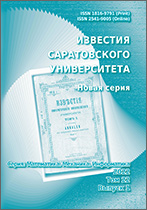|
This article is cited in 1 scientific paper (total in 1 paper)
Scientific Part
Mechanics
On the physical equations of a deformable body at the loading step with implementation based on a mixed FEM
N. A. Gureevaa, R. Z. Kiselevab, Yu. V. Klochkovb, A. P. Nikolaevb, V. V. Ryabukhab
a Financial University under the Government of the Russian Federation, 49 Leningradsky Prospekt, GSP-3, Moscow 125993, Russia
b Volgograd State Agricultural University, 26 Universitetskiy Prospekt, Volgograd 400002, Russia
Abstract:
To obtain the deformation matrix of the prismatic finite element at the loading step, taking into account the physical nonlinearity, three variants of physical equations were used. In the first variant, the defining equations of the theory of plastic flow are implemented, according to which the increment of deformations is divided into elastic and plastic parts. The increment of elastic deformations is related to the increments of stresses by Hooke's law. The relationship of plastic strain increments with stress increments is determined based on the hypothesis of the proportionality of the components of the plastic strain increment tensor to the components of the stress deviator. In the second variant, the components of the plastic strain increment tensor are obtained on the basis of the proposed hypothesis about the proportionality of these components to the components of the stress increment deviator at the loading step. In this variant, as well as in the first variant, the hypothesis of incompressibility of the material during plastic deformation is accepted. In the third variant, the defining equations at the loading step were obtained on the basis of the proposed hypothesis about the proportionality of the components of the deformation increment deviator to the components of the stress increment deviator without dividing the deformation increments into elastic and plastic parts. The proportionality coefficient turned out to be a function of the chord modulus of the deformation diagram. The hypothesis of incompressibility of the material during plastic deformation was not accepted, but the dependence between the first invariants of strain tensors and stress tensors obtained from the experiment was realized. For comparison with the first and second variants of the defining equations, this dependence between the first invariants of strain and stress tensors is determined by the elastic deformation formula. A prismatic element with triangular bases is adopted as the finite element. Displacement increments and stress increments are taken as nodal unknowns. Approximation of the desired values of the finite element method, in a mixed formulation through nodal values, was carried out using linear functions. The stress-strain state matrix is presented on the basis of a mixed functional obtained from the physical expression of the equality of the possible and actual work of external and internal forces at the loading step with the replacement of the actual work of internal forces by the difference of the full and additional work of internal forces. The calculation example shows an adequate correspondence in the calculation results based on the considered variants of the physical relations and the preference of the third variant of the defining equations of the theory of plasticity is noted.
Key words:
defining plasticity equations, deformation increment deviators, stress increment deviators, mixed FEM.
Received: 09.02.2022
Accepted: 16.06.2022
Citation:
N. A. Gureeva, R. Z. Kiseleva, Yu. V. Klochkov, A. P. Nikolaev, V. V. Ryabukha, “On the physical equations of a deformable body at the loading step with implementation based on a mixed FEM”, Izv. Saratov Univ. Math. Mech. Inform., 23:1 (2023), 70–82
Linking options:
https://www.mathnet.ru/eng/isu969 https://www.mathnet.ru/eng/isu/v23/i1/p70
|

|




 Contact us:
Contact us: Terms of Use
Terms of Use
 Registration to the website
Registration to the website Logotypes
Logotypes








 Citation in format
Citation in format 
